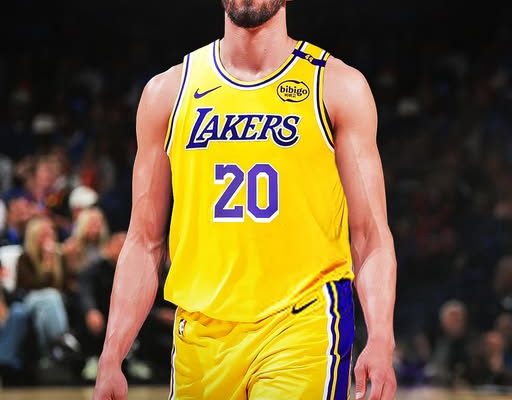The Los Angeles Lakers spent much of the 2025 postseason battling themselves on the perimeter. As defenses collapsed in the paint and dared their shooters to take over, the Lakers’ Achilles’ heel was revealed in plain sight: a deep shooting deficiency that couldn’t be ignored any longer. In a league where spacing and efficiency are the currency of championship contenders, the Lakers lacked one of the most crucial weapons in modern basketball—reliable three-point shooting, particularly off the bench. In this context, the potential acquisition of Landry Shamet might seem like a quiet move to casual fans. But to those who’ve watched this team struggle with floor spacing when the lights are brightest, Shamet could be the difference between another early playoff exit and a deep postseason run.
Landry Shamet is not a household name in the vein of LeBron James, Anthony Davis, or even D’Angelo Russell. But what he brings to the table fits exactly into one of the Lakers’ most glaring needs: consistent, playoff-proven outside shooting from a bench player who doesn’t shrink in big moments. While Shamet’s overall career arc hasn’t included All-Star nods or gaudy stat lines, what he has delivered time and again—especially when it matters most—is knockdown perimeter shooting and a mental toughness that few role players possess.
In the 2025 NBA Playoffs, Shamet posted an astounding 46.7% shooting clip from beyond the arc. That number isn’t just impressive; it’s elite. It’s the kind of marksmanship that shifts defensive schemes, bends floor spacing, and keeps opposing coaches awake at night. And for a Lakers team that sputtered offensively anytime their starters sat down, Shamet’s efficiency would inject instant life into a second unit that lacked a spark. The Lakers’ bench often stalled the offense, relying on isolation play or inconsistent slashing without the spacing to maximize those drives. Shamet changes that calculus immediately.
What’s perhaps more important than just his raw shooting percentage is the context in which Shamet hit those shots. These weren’t empty-calorie numbers padded in garbage time or meaningless regular-season contests. Shamet’s 2025 playoff performance was defined by timely daggers, big-moment confidence, and the ability to execute under pressure. With the league’s pace increasing and spacing at a premium, every bench unit that wants to survive in the playoffs needs at least one reliable sniper. Shamet fits that mold perfectly.
Moreover, Shamet’s movement off the ball is an underrated element of his game that would dovetail seamlessly with the Lakers’ offensive design. Too often last season, the Lakers’ off-ball movement stagnated when the bench came in. With Shamet, not only does the team get a lethal shooter, but also a player who keeps defenders honest simply by how he navigates screens and creates catch-and-shoot opportunities. This opens up lanes for other second-unit players, be it a driving guard like Gabe Vincent or a slashing forward like Rui Hachimura.
The Lakers’ 2025 postseason numbers underscore just how necessary a player like Shamet could be. As a team, the Lakers shot a paltry 31.6% from three in the playoffs. Their bench unit, in particular, failed to eclipse 30% from long range across multiple series. In today’s NBA, that sort of inefficiency is a death sentence. Teams like the Denver Nuggets, Boston Celtics, and even the upstart Oklahoma City Thunder all ran out deep benches capable of stretching the floor. That edge was glaringly absent in Los Angeles.
It wasn’t for lack of trying. The Lakers experimented with various rotations, hoping players like Max Christie, Cam Reddish, and even Spencer Dinwiddie could provide an offensive jolt. But inconsistency plagued the entire second unit. Christie had flashes of brilliance but lacked experience. Reddish brought length and athleticism but couldn’t find his rhythm from beyond the arc. Dinwiddie, while competent as a playmaker, didn’t scare defenses from deep. Shamet not only brings a reliable shot but also demands defensive attention.
Another overlooked aspect is Shamet’s postseason pedigree. Despite being just 28, Shamet has already appeared in 60+ playoff games across stints with multiple franchises including the 76ers, Clippers, Nets, Suns, and most recently the Wizards. He’s battle-tested. He knows what it takes to play on the biggest stages. And more importantly, he’s thrived in a variety of systems, whether that’s high-pace, motion-heavy offenses or slower, half-court sets. That kind of versatility makes him plug-and-play ready for a Lakers team that is still shaping its bench identity under head coach JJ Redick.
Speaking of Redick, Shamet’s arrival would almost certainly be music to the ears of a coach who built his own NBA career on shooting mechanics, off-ball movement, and spacing IQ. Redick understands better than anyone the value of a player like Shamet. Having someone who can execute a flare screen read, slip into space, and confidently knock down threes from either corner or above the break could unlock new offensive layers. Redick has already indicated his desire to modernize the Lakers’ offense, and Shamet is tailor-made for such a transition.
There are concerns, of course. Shamet is not a plus defender, and at times can be targeted on switches. However, in a bench role with the right matchups, his defensive shortcomings are far less exploitable—especially when surrounded by longer, more versatile wings and rim protection like Anthony Davis. The Lakers wouldn’t need Shamet to be a stopper. They’d simply need him to hold his ground and make the opponent think twice about leaving him open.
His contract is also relatively friendly. At under \$11 million annually, Shamet represents excellent value for a shooter of his caliber. In a world where average wings command \$15–20 million without playoff consistency, Shamet is a cost-effective alternative who has already proven his worth under pressure. For a team juggling financial constraints while trying to maximize LeBron’s final championship window, this type of move aligns perfectly with both roster needs and cap strategy.
More than anything, Landry Shamet represents the type of under-the-radar solution that championship teams often rely on. Superstars win games, but role players win series. Think back to the 2021 Milwaukee Bucks—Bryn Forbes had a series-changing stretch from three. The 2022 Warriors leaned on Otto Porter Jr. to keep spacing alive. Even the 2023 Nuggets had Bruce Brown to swing momentum in key moments. Shamet, if healthy and locked in, could very well be that swing piece for the 2026 Lakers.
There’s also the chemistry element to consider. Shamet has earned high marks across the league for his professionalism, work ethic, and locker-room demeanor. With the Lakers managing multiple personalities and the pressure of constant media attention, having a low-maintenance, team-first player like Shamet is a welcome addition. He doesn’t need the spotlight. He just needs minutes—and he knows exactly what to do with them.
The Lakers’ offseason has been full of speculation, from potential trades for stars to internal debates about fit and future. But sometimes, the most impactful move isn’t the flashiest one. Sometimes it’s about addressing the quiet problems with equally quiet solutions. Shamet won’t dominate headlines. But he may dominate stat sheets when it counts.
So while the basketball world keeps its eyes on blockbuster moves and marquee names, the Lakers might have just quietly solved one of their loudest issues. Landry Shamet, with his quick release, steady nerves, and playoff poise, could be the unexpected hero in Hollywood’s next title run. The Lakers don’t need him to be a star—they just need him to hit shots when it matters. And based on his recent track record, he’s more than ready.


